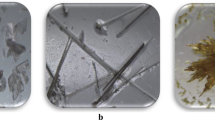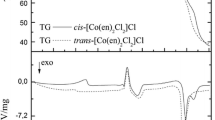Abstract
May and Filella (J Solution Chem 52:754–761, 2023) concluded that they had verified the data in Gamsjäger et al. (Chemical thermodynamics of tin OECD, Nuclear Energy Agency Data Bank, Leoben, 2012). However, they used exactly the same primary data and not surprisingly came up with essentially the same values. They (1) provided no new data; (2) did not comment on/re-evaluate the existing experimental data (e.g., Sn–Cl complexes) that determine the accuracy of the E0 value for the (Sn4+/Sn2+) couple, but instead relied on a calculated value that is precise but of questionable accuracy; (3) disregarded extensive cassiterite (SnO2(cass)) solubility data that is critical to (a) ascertaining the accuracy of the E0 value based on \({\mathrm{Sn}(\mathrm{Cl})}_{y}^{4-\mathrm{y}}\) complexes presented in Gamsjäger et al. (2012) and May and Filella (2023), (b) determining the solubility product of SnO2(cass), and (c) determining reliable overall K0 values for SnO2(s) solubility reactions involving \({\mathrm{Sn}(\mathrm{OH})}_{n}^{4-n}\) instead of Sn4+; and (4) in no way help resolve the many orders of magnitude differences in reported K0 values for various Sn(IV)–OH system reactions. These issues were extensively addressed in Rai (J Solution Chem.51:1169–1186, 2022) and are briefly discussed herein, and they help to determine that, contrary to May and Filella’s (2023) conclusions, the Sn(IV)–OH system thermodynamic constants presented in Rai (2022) are indeed reliable.

Similar content being viewed by others
Notes
Namely: solubility product based on potential difference data of Gamsjäger et al. [2]; SnO2(cass) solubility data [3] that are extremely limited, available only for (2 > pH < 8), where Sn(IV) concentrations as a function of pH are constant and at or near the detection limits; SnO2(am) solubility data [3] that did not extend to pH < 2 and in (2 > pH < 8) is similar (about an order of magnitude higher) to SnO2(cass) solubility where measured concentrations are at or near the detection limits.
This is not so because the calculated E0 value is entirely dependent on the strength of Sn–Cl complexes (also see Footnote 3), and as discussed below and in [4] the very existence of such complexes for \({\mathrm{Sn}(\mathrm{Cl})}_{y}^{4-y}\) with extremely high \({\beta}_{y}^{0}\) values is questionable.
An increase in the values for the formation of (Sn(IV)–Cl) complexes would decrease Sn(IV)free and increase the E0 value; an increase in values for (Sn(II)–Cl) complexes would decrease Sn(II)free and decrease the E0 value.
Owing to the fact that their recommended value of log10 \({K}_{\mathrm{s0}}^{0}\) for SnO(cass) is extremely low.
Experimental solubility of SnO2(cass) at (> 2 pH < 8) (Rai et al. [7]) are similar (an order of magnitude lower) to the data [3] that May and Filella [1] considered reliable. Because the (> 2 pH < 8) data are similar to the data they considered reliable, there is no reason to suspect the accuracy of the data at (< 2 pH > 8).
The pH-independent concentrations in solubility experiments involving sparingly soluble solids such as SnO2(cass) may or may not represent accurate values. This is because very often these concentrations are based on analytical detection limits of the analysis techniques and a whole host of other parameters. These parameters could include effectiveness of methods used to separate solids from solutions, whether the solubility is approached from over- or under-saturation direction, and the presence of a finite amount of more soluble solid than the solid used in experiments.
References
May, P.M., Filella, M.: Thermodynamic data for Sn(IV) species in aqueous solution: a matter of controversy and error. J. Solution Chem. 52, 754–761 (2023)
Gamsjäger, H., Gajda, T., Sangster, J., Saxena, S.K., Voigt, W.: Chemical Thermodynamics of Tin OECD. Nuclear Energy Agency Data Bank, Leoben (2012)
Amaya, T., Chiba, T., Suzuki, K., Oda, C., Yoshikawa, H., Yui, M.: Solubility of Sn(IV) oxide in dilute NaClO4 solution at ambient temperature. Mat. Res. Soc. Symp. Proc. 465, 751–758 (1997)
Rai, D.: Thermodynamic data for Sn(IV) dioxides and hydroxido complexes: a critical review. J. Solution Chem. 51, 1169–1186 (2022)
Huey, C.S., Tartar, H.V.: The stannous-stannic oxidation-reduction potential. J. Am. Chem. Soc. 56, 2585–2588 (1934)
Forbes, G.S., Bartlett, E.P.: The measurement of oxidation potentials at mercury electrodes. I. The stannic stannous potential. J. Am. Chem. Soc. 56, 2030–2040 (1914)
Rai, D., Yui, M., Schaef, H.T., Kitamura, A.: Thermodynamic model for SnO2(cr) and SnO2(am) solubility in the aqueous Na+–H+–OH––Cl––H2O system. J. Solution Chem. 40, 1155–1172 (2011)
Rand, M.H., Fuger, J., Grenthe, I., Neck, V., Rai, D.: Chemical thermodynamics of thorium. OECD Nuclear Energy Agency, Paris (2008)
Gajda, T., Sipos, P., Gamsjäger, H.: The standard electrode potential of the Sn4+/Sn2+ couple revisited. Monatsh Chem. 140, 1293–1303 (2009)
Feitknecht, W., Schindler, P.: Solubility constants of metal oxides, metal hydroxides and metal hydrozide salts in aqueous solution. Pure Appl. Chem. 1, 130–199 (1963)
Guillaumont, R., Fanghanel, T., Fuger, J., Grenthe, I., Neck, V., Palmer, D.A., Rand, M.H.: Update on the chemical thermodynamics of uranium, neptunium, plutonium, americium, and technetium. Elsevier, B.V, Amsterdam (2003)
Rai, D., Kitamura, A., Altmaier, M., Rosso, K.M., Sasaki, T., Kobayashi, T.: A thermodynamic model for ZrO2(am) solubility at 25°C in the Ca2+–Na+–H+– Cl−–OH−–H2O system: a critical review. J. Solution Chem. 47, 855–891 (2018)
Lothenbach, B., Ochs, M., Wanner, H., and Yui, M.: Thermodynamic data for the speciation and solubility of Pd, Pb, Sn, Sb, Nd, and Bi in aqueous solutions. JNC TN8400 99-011. 1999, Japan Nuclear Cycle Development Institute, now Japan Atomic Energy Agency
Author information
Authors and Affiliations
Contributions
DR wrote the entire document.
Corresponding author
Ethics declarations
Conflict of interest
There are no conflicts of interest to declare.
Additional information
Publisher's Note
Springer Nature remains neutral with regard to jurisdictional claims in published maps and institutional affiliations.
Rights and permissions
Springer Nature or its licensor (e.g. a society or other partner) holds exclusive rights to this article under a publishing agreement with the author(s) or other rightsholder(s); author self-archiving of the accepted manuscript version of this article is solely governed by the terms of such publishing agreement and applicable law.
About this article
Cite this article
Rai, D. Comment on “Thermodynamic Data for Sn(IV) Species in Aqueous Solution: Matter of Controversy and Error”. J Solution Chem 52, 1386–1393 (2023). https://doi.org/10.1007/s10953-023-01323-x
Received:
Accepted:
Published:
Issue Date:
DOI: https://doi.org/10.1007/s10953-023-01323-x




